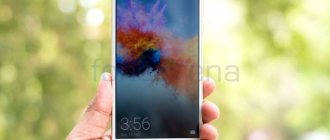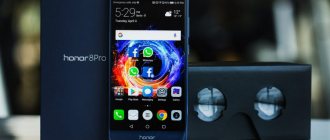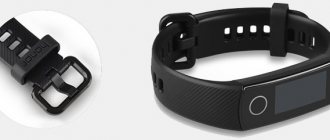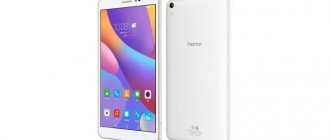Metal and plastic
The Chinese smartphone from the front looks the same as hundreds of faceless smartphones, but the rear surface is supplemented with a metal insert. Inexpensive phones are loved not for their design, but for their characteristics, when you squeeze out the maximum of Chinese power for hard-earned rubles.
Honor 5C turned out to be a presentable device: it is neatly assembled, looks nice, and costs adequately.
Shell and operating system
This model, like all other smartphones from Huawei, uses the proprietary EMUI shell version 4.1 (Russian is already available in this version). I would like to note that with each new update it becomes simpler and more stylish in the interface (for example, standard application icons, not “Chinese”), but the functionality, on the contrary, is expanding.
Also among the advantages are the already installed Swype input, the most functional notification panel and the Russian language in the phone number dialing window. There are also a number of standard applications, which, of course, can be removed if no longer needed.
However, there is also a minus here: since Chinese manufacturers are very fond of adding many energy-saving functions to their gadgets, push notifications are often delivered with a delay.
Bright screen without oleophobic coating
A display with a resolution of 1080x1920 pixels and a diagonal of 5.2 inches without an air gap, “cold” color rendering and an IPS matrix, the picture looks equally good from all sides.
To my surprise, the smartphone did not have an oleophobic coating. This is usually the fault of the greedy developers of LG smartphones, but the Chinese usually give it their all. But no, this time Huawei decided to save a pretty penny.
Wireless Interfaces and Communications
Huawei smartphones have always been famous for their connection quality, because the signal here is much better than in many popular gadgets (for example, the iPhone 5S). The GPS navigator also works stably, and the location is determined with an accuracy of up to a meter. The gadget also has an NFC module installed.
The smartphone supports the installation of either two SIM cards, or one SIM and a micro-SD memory card. It’s not very practical, but this format is now used by almost all mobile device manufacturers, so Huawei hasn’t invented anything new.
Is there enough power?
The smartphone has a Huawei Kirin 650 processor, 2 GB of RAM, 16 GB of its own and a slot for a microSD card. Here it is comparable to other devices at a similar price; I added several models of a similar level to the test table.
Honor 4c in tests Create bar charts
There are no serious lags, the shell is fast, toys don’t work at maximum, but the phone costs 3 times less than the Huawei flagship, which is logical.
Good performance without overheating the case in games.
The 3000 mAh battery takes longer than 2.5 hours to charge using the included 1A charger; there is no Quick Charge function. In an hour of Real Racing 3 racing, the phone drains by 25%; on average, charging lasts for a day. In terms of autonomy, it is no different from the P9 Lite with similar hardware.
⇡#Hardware and performance
Perhaps the key difference between the Honor 5X and 5C is that the 5X is built on the Qualcomm Snapdragon 615 platform, and the 5C is built on the HiSilicon Kirin 650 chip. It is logical to assume, given the experience of operating devices on previous generations of HiSilicon platforms, that the 5X will be much faster than its predecessor. younger brother. But no, that’s not the case! In synthetic tests, Honor 5C outperforms the more expensive model. For example, in the AnTuTu Benchmark 6 test the advantage is almost twofold.
Interestingly, the HiSilicon Kirin 650 system-on-chip, which is designed for mid-priced devices, is made using a 16 nm process technology. This is rare in this class of devices - platforms made using 28 nm technology prevail here. As a result, Honor 5C consumes less power than most of its classmates, while not being inferior to them in power - and in most cases, even superior.
This platform includes eight ARM Cortex-A53 cores, four of which operate at a frequency of 1.7 GHz, and four more at a frequency of 2 GHz. The ARM big.LITTLE architecture and the current ARMv8-a instruction set are used, and 64-bit computing is supported. The smartphone has two gigabytes of RAM and 16 GB of built-in flash memory, of which about eleven are available to the user. The device can work with microSD memory cards with a capacity of up to 128 GB.
The role of the graphics controller is played by the ARM Mali-T830 MP2 module. The device easily displays video in the display’s native Full HD resolution; the built-in media player knows many common video codecs.
You can also play on your smartphone, including resource-intensive toys. True, to do this you will have to reduce the graphics settings to a minimum and periodically put up with a “flickering” image - from time to time the device may stumble under particularly high loads.
The Honor 5C works quite stably, handles all everyday tasks well, displays the operating system animation in most cases without jerks, although there were some unpleasant moments during testing - but as an exception. The device easily stores many open applications in memory and quickly switches between them. For a mid-priced smartphone, there is enough power here; no excess – but enough.
Regular camera
Let's start with the main thing: not a single budget phone will take good photos on the street in the evening. The Honor 5C has a night mode, but it requires a tripod, otherwise the picture comes out blurry, which is not fun for everyone.
I was surprised by how HDR works: the effect is invisible, whether you turn it on or not. Otherwise, this is an ordinary smartphone: it takes pictures well during the day, takes bright photos with good detail and misses the mark with colors. Pointed, shot, moved on, except that autofocus is not the fastest.
⇡#Autonomous work
The smartphone has a non-removable 11.4 Wh (3000 mAh, 3.8 V) battery. This is quite a decent capacity. The already mentioned energy efficiency of the hardware platform plays into the hands of the smartphone. Due to this combination, the gadget consistently lasted until the end of the working day without recharging, even under relatively high loads. You won't have to charge Honor 5C more than once a day. A full charging cycle using the included charger takes about two and a half hours.
In our standard test of playing HD video at maximum screen brightness, with an active Wi-Fi connection and data updating in the background, the gadget worked for seven hours - a decent result. Of course, if you lower the brightness level and also adjust all the software energy saving modes, as they say, to suit you, you can extend the life of the battery by a couple of hours - this setting is worth spending time on.
| Honor 5C – power saving options | ||||
Connection
The earpiece is loud, and the call can also be heard well; the sound quality through the media speaker is so-so. But if you don’t listen to music through it, but use it to receive notifications and calls, then it will suit you.
Two SIM cards with fast LTE to boot, but if you install two cards, there will be no room for microSD.
The smartphone has two SIM cards, LTE, GPS and GLONASS. The connection quality is good, the reception is stable, Huawei has been producing telecom equipment for so many years, smartphones are no exception.
Features of Huawei Honor 5C in detail
Platform
Chipset HiSilicon Kirin 650 Octa core CPU 4 x ARM Cortex-A53 @ 2.00 GHz 4 x ARM Cortex-A53 @ 1.70 GHz 64-bit Yes GPU ARM Mali-T830 MP2 @ 800 MHz NPU No Process technology 16 nm FinFET+
Memory
RAM 2 Gb - LPDDR3 @ 933 MHz (Single Channel) Built-in storage 16 Gb - eMMC 5.1 Memory expansion Yes Memory card types microSD, microSDHC, microSDXC Maximum capacity 128 Gb Dedicated slot No data
Screen
Resolution 1080 x 1920 (FullHD) Aspect ratio 9:16 Matrix type IPS Diagonal 5.2″ Area ~74.5 cm2 Fill percentage ~68.6% (of the total front surface area) Pixel density ~424 ppi Security Yes
Connection
Communication standards GSM, UMTS, LTE 2G GSM 850/900/1800/1900 MHz 3G WCDMA B1 2100 MHz, B20 800 MHz, B5 850 MHz, B8 900 MHz 4G LTE FDD B1 2100 MHz, FDD B19 800 MHz, FDD B28 700 MHz , FDD B3 1800 MHz, FDD B5 850 MHz, FDD B7 2600 MHz, FDD B8 900 MHz, TDD B40 2300 MHz LTE support Yes LTE categories Category-6 LTE speed Up to 300 Mbit/s in data download mode, up to 50 Mbit/s in transmit mode LTE device categories indicate the maximum speed at which it can send and receive data on 4G LTE networks through carrier aggregation. Number of SIM cards 2 Type of SIM cards Nano SIM
Cameras
Main camera
Type Single Resolution 13.0 MP Autofocus Yes Aperture No data Flash LED
Front-camera
Resolution 8.0 MP Aperture No data
Interfaces
WiFi IEEE 802.11 b/g/n, 2.4 GHz, Wi-Fi Direct, DLNA, access point mode Wi-Fi is a technology for building wireless local networks based on the IEEE 802.11 family of standards. Supported by all modern smartphones and many mobile phones. Bluetooth v4.1 Bluetooth is a universal wireless interface for exchanging data between various types of devices at close range. Can be used for file transfer, audio streaming, network connection, printing and other purposes. The newer the version, the greater the speed and number of supported profiles. Navigation GPS, A-GPS, GLONASS For at least 10 years, smartphones have supported the geolocation function using data from satellite navigation systems. At the moment, these are the American-developed GPS, the Russian GLONASS, the Chinese BeiDou and the European GALILEO. As a rule, smartphones support the first two and optionally the rest. NFC No The built-in NFC module of a smartphone is mainly used for contactless payment in applications like Google Pay and Samsung Pay. Can also be used to read data from contactless cards, transfer files, etc. Read more here. Infrared port No Some smartphones have a built-in IR port. In the past, it was used to synchronize data both between two mobile phones and between a phone and a PC. However, now, due to its low speed, the infrared port is used mainly to control external devices in remote control mode. FM radio No Built-in radio receiver that allows you to listen to radio stations operating in the FM range. In most cases, it only works when headphones are connected, since the wire is used as a communication antenna. However, there are devices with a built-in antenna. 3.5 mm audio Yes Standard audio jack for connecting wired headsets and headphones. Starting in 2021, some smartphone manufacturers, following Apple, began to abandon it. In this case, to connect regular headphones, you need a special adapter for Lightning/USB Type-C. USB Micro USB, On-The-Go The type of USB connector installed in the smartphone and the capabilities it supports.
Sensors and biometrics
Sensors Accelerometer, Light sensor, Electronic compass, Gravity sensor, Proximity sensor Fingerprint scanner Yes Scanner location On the back of the body Scanner reaction time No data Face scanner (Face ID) No Iris scanner (IRIS) No
Power supply
Battery capacity 3000 mAh Battery type Li-ion Removable battery No Fast charging No Wireless charging No
Software
Operating system Android 6.0 Marshmallow EMUI shell Over-the-air (OTA) update Yes Sending messages SMS, MMS, Email, Push Email, IM Internet browser HTML5, CSS, JavaScript Audio formats 3GP, AAC, AMR, FLAC, MP3, MP4, OGG, RA, WAV, WMA Video formats 3GP, ASF, MP4, RM, RMVB, WMV Graphic formats BMP, GIF, JPEG, JPG, PNG Voice assistant Google Assistant
Physical parameters
Dimensions 147.1 x 73.8 x 8.3 mm Weight 158 g Package dimensions 168.0 x 96.0 x 61.0 mm Package weight 362 g Protection class No Colors Gray, Silver
Performance
Geekbench 805 / 3316 (Single core / Multi core) Huawei Honor 5C performance assessment according to the popular GeekBench benchmark.
Average data are shown. AnTuTu 52934 points Performance assessment of Huawei Honor 5C according to the popular AnTuTu benchmark. Average data are shown. PassMark 4989 / 134365 (PassMark Rating / CPUMark Rating) Huawei Honor 5C performance assessment according to the popular PassMark benchmark. Important note : unfortunately, we cannot guarantee 100% accuracy of all data presented on this page, but we are constantly working in this direction. If you notice an error in the device settings, we will be very grateful if you report it in the comments.
Top
Or maybe buy another Huawei?
I recently wrote about Huawei P9 Lite, it costs 20 thousand and for that kind of money it turned out to be a good device. It seems that the Chinese decided: let’s do the same thing, but cheaper, by releasing Honor 5C. So why do you need P9 lite then? It is thinner and lighter, has an oleophobic coating, and shares the glory of the Huawei P9 series with the Leica brand.
The difference is in the sales strategy: Honor 5C will focus on online trading, and P9 Lite will go through retail stores, where you come and touch it.
Moreover, Huawei also has the Honor 5X: it has a larger screen and a fingerprint scanner, but lower performance and the old Android 5.1. It costs a couple thousand more than the Honor 5C. In general, here you will think about which Huawei to choose.
⇡#Appearance and ergonomics
We usually don’t expect non-standard and interesting design solutions from inexpensive smartphones - here the emphasis, as a rule, is on functionality. There is no doubt - the 5C looks quite standard for an Android smartphone, and the only thing that distinguishes it from a dozen similar competitors is the “Honor” inscription at the bottom of the front panel. Nevertheless, we have already mentioned one of its important features - the Honor 5C has a metal body. Let this happen more and more often lately, but not so much as to perceive it as commonplace. At a price of less than 15 thousand rubles, such performance not only cools the hand, but also warms the soul.
Honor 5C – front panel
Getting used to the Honor 5C is easy. As is often the case, there are no hardware keys on the front panel; the system navigation buttons are touch sensitive and are located on the display. At the top of the front panel there is a slot for the earpiece and the front camera lens.
Honor 5C – front panel
The device weighs 156 grams – only two grams less than the larger Honor 5X. The thickness of the case is 8.3 millimeters - not everything is great here, we are already accustomed to the fact that modern Android gadgets are usually thinner than eight millimeters. However, Honor 5X is almost identical here.
Honor 5C – side view
The power and volume keys are located on the right side. The audio output for connecting a wired headset is on the top edge, and the microUSB interface along with the speaker slots is on the bottom. Nano-SIM and microSD cards (or a second Nano-SIM, universal slot) are installed in a special tray on the left side.
| Honor 5C – location of connectors and keys | ||
The back panel of the gadget is smooth, it can slide in wet palms. Moreover, the surface of the “back” collects fingerprints and dust well – the smartphone loses its presentation quite quickly, even if this can be corrected with the help of any cloth. Despite the characteristic contour, the body of the Honor 5C is non-separable - accordingly, users do not have access to the battery.
Honor 5C – rear panel
To be honest, the device is not assembled in the best way: when testing for twisting and breaking, there is quite a characteristic play, creaking can be heard - the parts are not ideally fitted to each other. By the way, all this was also observed in the more expensive Honor 5X - here they are, signs of savings!
Competitors
Honor 5C was priced at 14,990 rubles, so what else can you buy for the same money? Xiaomi Redmi 3 has officially arrived here, but for the 3/32 GB version they are asking 17 thousand, which is a bit expensive. Meizu M3s is not on sale yet, it will apparently also cost about 14 thousand.
Lenovo also has a trump card: last year’s ZUK Z1 is sold for 14,990, and there is top-end hardware from two years ago, it is still relevant. If you look towards Samsung, then the Samsung Galaxy J5, which is similar in characteristics, costs 17 thousand. The Koreans have nothing to show off; the Chinese have pulled the blanket over themselves.
Display
Huawei Honor 5a has a five-inch IPS screen with a resolution of 1280x720 pixels and a density of 294 ppi. Looking ahead, I would like to say that the screen, despite all the concerns, turned out to be of very high quality, which is even a little unusual, considering the budget segment of the device.
Colors are rendered natural, contrast and white are at a very high level, in the best traditions of high-quality IPS matrices. And even the blacks seemed quite deep and rich to us, which is a very rare occurrence for this type of screen, even in more expensive phones. Viewing angles are also good, with colors not inverted at very extreme angles, but the overall brightness of the image still drops quite a bit, reminding us that nothing is perfect. Also, some people may be upset that the colors cannot be made more saturated: after all, this is not an AMOLED.
The clarity of the screen, thanks to the HD resolution, is also quite good; the only thing that didn’t please me was individual fonts, which turned out to be a little blurry. The maximum brightness of the smartphone is approximately 430 cd/m2, which is a very good result for a budget employee. In bright sunlight, the screen fades a little, but in principle remains readable. An automatic screen brightness adjustment function is also available, but it works quite slowly and is mostly annoying. For manual settings, in addition to display brightness, not much is available to the user, namely setting fonts and adjusting color temperature.
In the multi-touch test, the display showed support for up to five simultaneous touches, which, in principle, is currently quite enough for the vast majority of applications. But the oleophobic coating was not very pleasing. At first glance it seemed that it was not there at all, however, after using the device longer, we concluded that it was still present, but in itself not of very high quality.
In the end, I must say that the screen of the Honor 5a turned out to be very good and even today it looks quite good. We can safely give the smartphone a plus for this parameter.
conclusions
Honor 5A at one time was a very good representative of the budget segment, capable of competing on equal terms with famous top brands. And surprisingly, it has not lost its relevance to this day. Yes, time is running out, the smartphone is equipped with an outdated operating system, has a rather weak processor by today’s standards and a small battery. But on the other hand, the 5a also retains many positive qualities, including an excellent tandem of the main and front cameras, an excellent display for the budget market, and fast expandable flash memory.
At one time, this device cost around 8,000 rubles, but today its cost is on average 7,000 rubles, and if you think sensibly, it’s difficult to find something better for that kind of money. Ultimately, if you come across this phone on a store shelf, whether you pay attention to it or not is up to you to decide. However, it is difficult to argue with the fact that Honor 5a still holds up at a decent level.
Sound
We probably won’t dwell on this point in too much detail, since there is simply nothing particularly interesting to talk about the sound of the Honor 5a. The sound from the external speaker of the device can be described as “normal”. Yes, to be honest, it is configured quite well, many thanks to the engineers for this. The phone tries its best to convey the full spectrum of the audio range, but no matter how hard it tries, the sound remains budgetary and you are unlikely to listen to music with it.
As for the sound in the headphones, it mostly depends on the headphones themselves and is loud enough to drown out all external noise, at least we were quite happy with the volume level. The volume of the speakers is enough to hear a call on the street, but it is better not to turn off the vibration. You can hear your interlocutor well, there are no particular complaints here. Let's move on.











